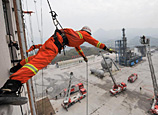
BEIJING - Chinese largest banks must keep their Capital Adequacy Ratio (CAR) no less than 9.5 percent by the end of 2013, the country's bank regulator said on Friday.
China Banking Regulatory Commission (CBRC) said the country's largest banks or "systemically important" ones have to keep their Tier 1 Capital Adequacy Ratio (TCAR) no less than 7.5 percent by the end of next year and Core Tier 1 Capital Adequacy Ratio (CCAR) at 6.5 percent or more.
Systemically important banks refer to those that are most significant to a country's economy and the collapse of them may lead to serious problems for the nation.
There is not a list of such banks, but Bank of China, Industrial and Commercial Bank of China, China Construction Bank, Agricultural Bank of China and Bank of Communications are believed to be systemically important.
The remaining banks, in accordance with CBRC requirements, must keep their CAR, TCAR and CCAR equal to or above 8.5, 6.5 and 5.5 percent respectively by the end of 2013.
CBRC gave specific requirements of these ratios for each year from 2013 to 2018, when CAR, TCAR and CCAR of systemically important banks should meet the requirements of 11.5, 9.5 and 8.5 percent respectively. The ratios of remaining banks should then reach 10.5, 8.5 and 7.5 percent.
The three ratios are a measure of the amount of a bank's capital as a percentage of its risk-weighted assets. These figures reflect a bank's capacity to cushion potential losses with its capital.
The commission also asked all banks to set aside an amount of reserve capital equal to 2.5 percent of their risk-weighted assets by the end of 2018.
To this end, the commission also gave steps each year for banks to follow from 2013 to 2018. Reserve capital is earmarked for a bank to buffer possible credit or operational risks.














 'Devil' foreign instructors at Chinese bodyguard training camp
'Devil' foreign instructors at Chinese bodyguard training camp


![]()
